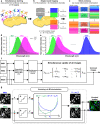PICASSO allows ultra-multiplexed fluorescence imaging of spatially overlapping proteins without reference spectra measurements
- PMID: 35513404
- PMCID: PMC9072354
- DOI: 10.1038/s41467-022-30168-z
PICASSO allows ultra-multiplexed fluorescence imaging of spatially overlapping proteins without reference spectra measurements
Abstract
Ultra-multiplexed fluorescence imaging requires the use of spectrally overlapping fluorophores to label proteins and then to unmix the images of the fluorophores. However, doing this remains a challenge, especially in highly heterogeneous specimens, such as the brain, owing to the high degree of variation in the emission spectra of fluorophores in such specimens. Here, we propose PICASSO, which enables more than 15-color imaging of spatially overlapping proteins in a single imaging round without using any reference emission spectra. PICASSO requires an equal number of images and fluorophores, which enables such advanced multiplexed imaging, even with bandpass filter-based microscopy. We show that PICASSO can be used to achieve strong multiplexing capability in diverse applications. By combining PICASSO with cyclic immunofluorescence staining, we achieve 45-color imaging of the mouse brain in three cycles. PICASSO provides a tool for multiplexed imaging with high accessibility and accuracy for a broad range of researchers.
© 2022. The Author(s).
Conflict of interest statement
I.C. and H.N. declare no competing interests. J.-B.C., Y.-G.Y., J.S., Y.S., H.K., and J.K. declare the following competing interests. J.-B.C., Y.-G.Y., J.S., Y.S., H.K., and J.K. are co-inventors on patent applications owned by KAIST covering PICASSO (KR10-2020-0088091, KR10-2021-0089419, KR10-2021-0090057, KR10-2021-0171431, US 17/132628, US17/445629, US17/567300, PCT/KR2021/011097, PCT/KR2021/018833, EP22150031.7, EP21192162.2).
Figures







Comment in
-
Unmixing for ultra-high-plex fluorescence imaging.Nat Commun. 2022 Jun 16;13(1):3473. doi: 10.1038/s41467-022-31110-z. Nat Commun. 2022. PMID: 35710800 Free PMC article.
Similar articles
-
Mosaic-PICASSO: accurate crosstalk removal for multiplex fluorescence imaging.Bioinformatics. 2024 Jan 2;40(1):btad784. doi: 10.1093/bioinformatics/btad784. Bioinformatics. 2024. PMID: 38175779 Free PMC article.
-
Multiplexed Spectral Imaging of 120 Different Fluorescent Labels.PLoS One. 2016 Jul 8;11(7):e0158495. doi: 10.1371/journal.pone.0158495. eCollection 2016. PLoS One. 2016. PMID: 27391327 Free PMC article.
-
Rapid Sequential in Situ Multiplexing with DNA Exchange Imaging in Neuronal Cells and Tissues.Nano Lett. 2017 Oct 11;17(10):6131-6139. doi: 10.1021/acs.nanolett.7b02716. Epub 2017 Oct 2. Nano Lett. 2017. PMID: 28933153 Free PMC article.
-
Ultra-stable organic fluorophores for single-molecule research.Chem Soc Rev. 2014 Feb 21;43(4):1044-56. doi: 10.1039/c3cs60237k. Chem Soc Rev. 2014. PMID: 24177677 Free PMC article. Review.
-
Spectral imaging and its applications in live cell microscopy.FEBS Lett. 2003 Jul 3;546(1):87-92. doi: 10.1016/s0014-5793(03)00521-0. FEBS Lett. 2003. PMID: 12829241 Review.
Cited by
-
Live-cell imaging powered by computation.Nat Rev Mol Cell Biol. 2024 Jun;25(6):443-463. doi: 10.1038/s41580-024-00702-6. Epub 2024 Feb 20. Nat Rev Mol Cell Biol. 2024. PMID: 38378991 Review.
-
Multiplexed Assay for Small-Molecule Quantification via Photo-cross-linking of Structure Switching Aptamers.ACS Omega. 2024 Oct 18;9(43):43785-43792. doi: 10.1021/acsomega.4c05258. eCollection 2024 Oct 29. ACS Omega. 2024. PMID: 39493996 Free PMC article.
-
Multiplex Protein Imaging through PACIFIC: Photoactive Immunofluorescence with Iterative Cleavage.ACS Bio Med Chem Au. 2023 Apr 28;3(3):283-294. doi: 10.1021/acsbiomedchemau.3c00018. eCollection 2023 Jun 21. ACS Bio Med Chem Au. 2023. PMID: 37363079 Free PMC article.
-
Creating coveted bioluminescence colors for simultaneous multi-color bioimaging.Sci Adv. 2025 Jan 24;11(4):eadp4750. doi: 10.1126/sciadv.adp4750. Epub 2025 Jan 22. Sci Adv. 2025. PMID: 39841832 Free PMC article.
-
Live-cell omics with Raman spectroscopy.Microscopy (Oxf). 2025 Jun 26;74(3):189-200. doi: 10.1093/jmicro/dfaf020. Microscopy (Oxf). 2025. PMID: 40271815 Free PMC article. Review.
References
-
- Zimmermann, T., Marrison, J., Hogg, K. & O’Toole, P. In Confocal Microscopy: Methods and Protocols (ed. Paddock, S. W.) 129–148 (Springer New York, 2014). - PubMed
-
- Zimmermann, T., Rietdorf, J. & Pepperkok, R. Spectral imaging and its applications in live cell microscopy. FEBS Lett. 10.1016/S0014-5793(03)00521-0 (2003). - PubMed
-
- Gorris, M. A. J. et al. Eight-color multiplex immunohistochemistry for simultaneous detection of multiple immune checkpoint molecules within the tumor microenvironment. J. Immunol. 10.4049/jimmunol.1701262 (2018). - PubMed
Publication types
MeSH terms
Substances
Associated data
LinkOut - more resources
Full Text Sources

